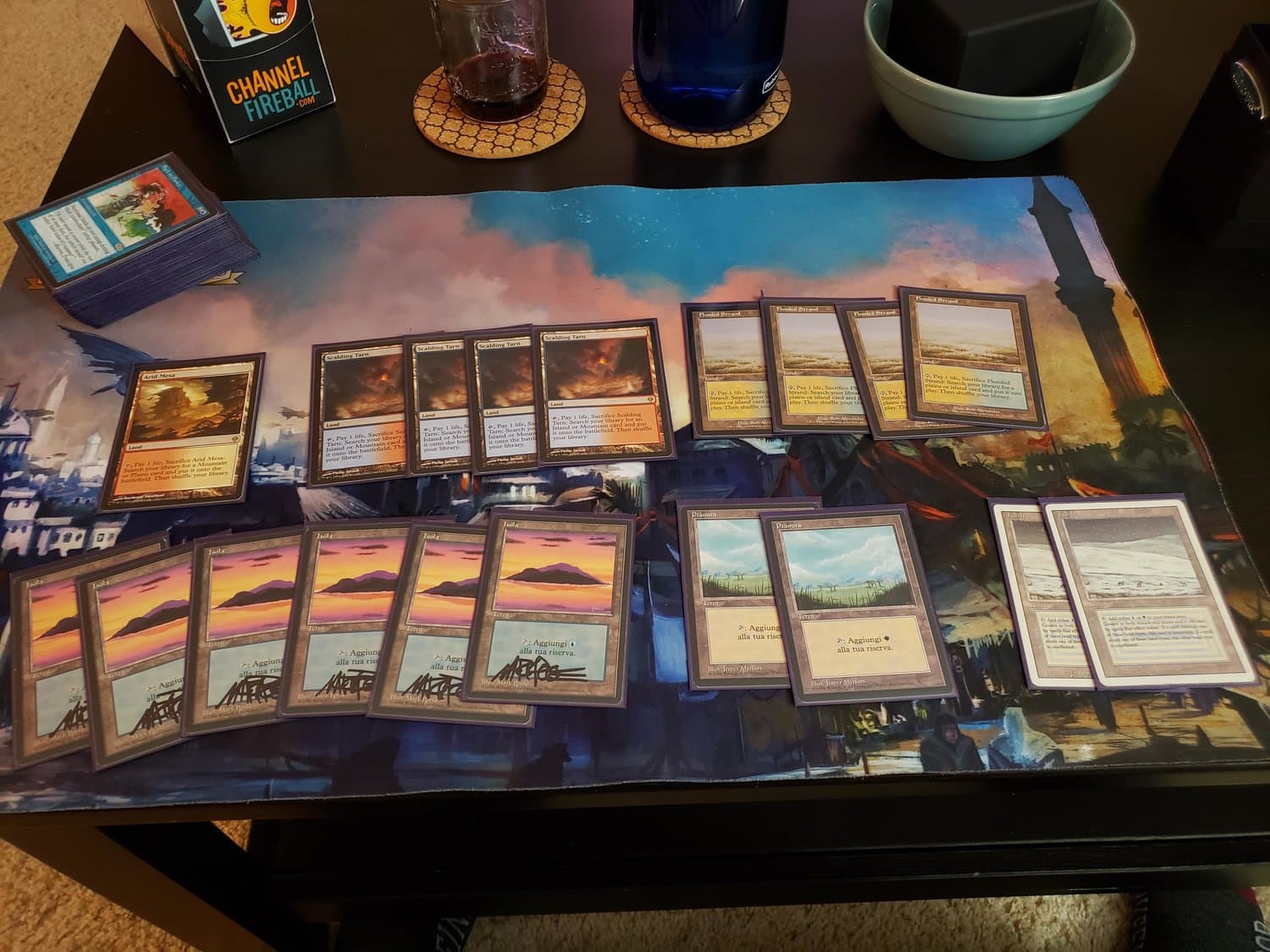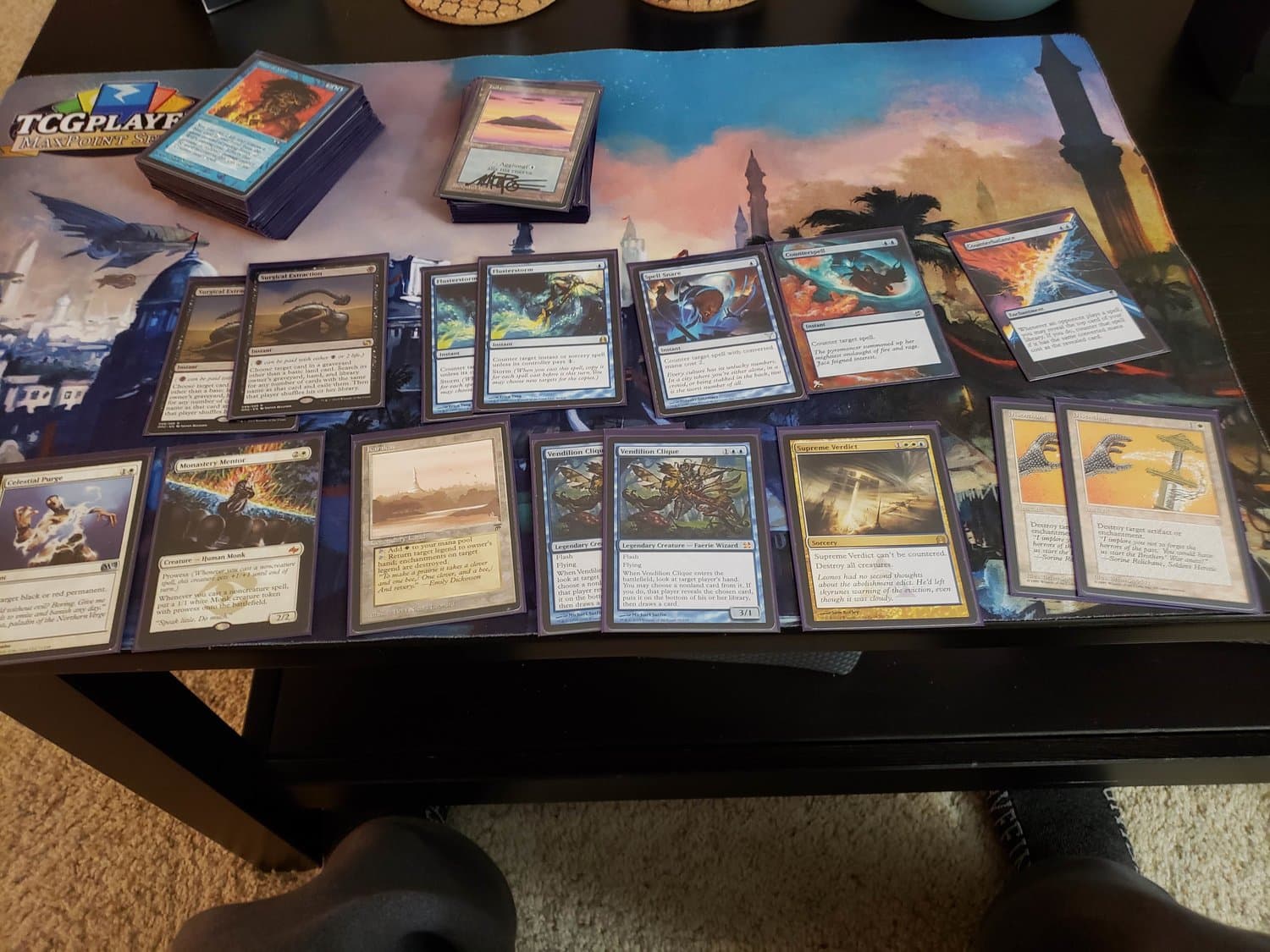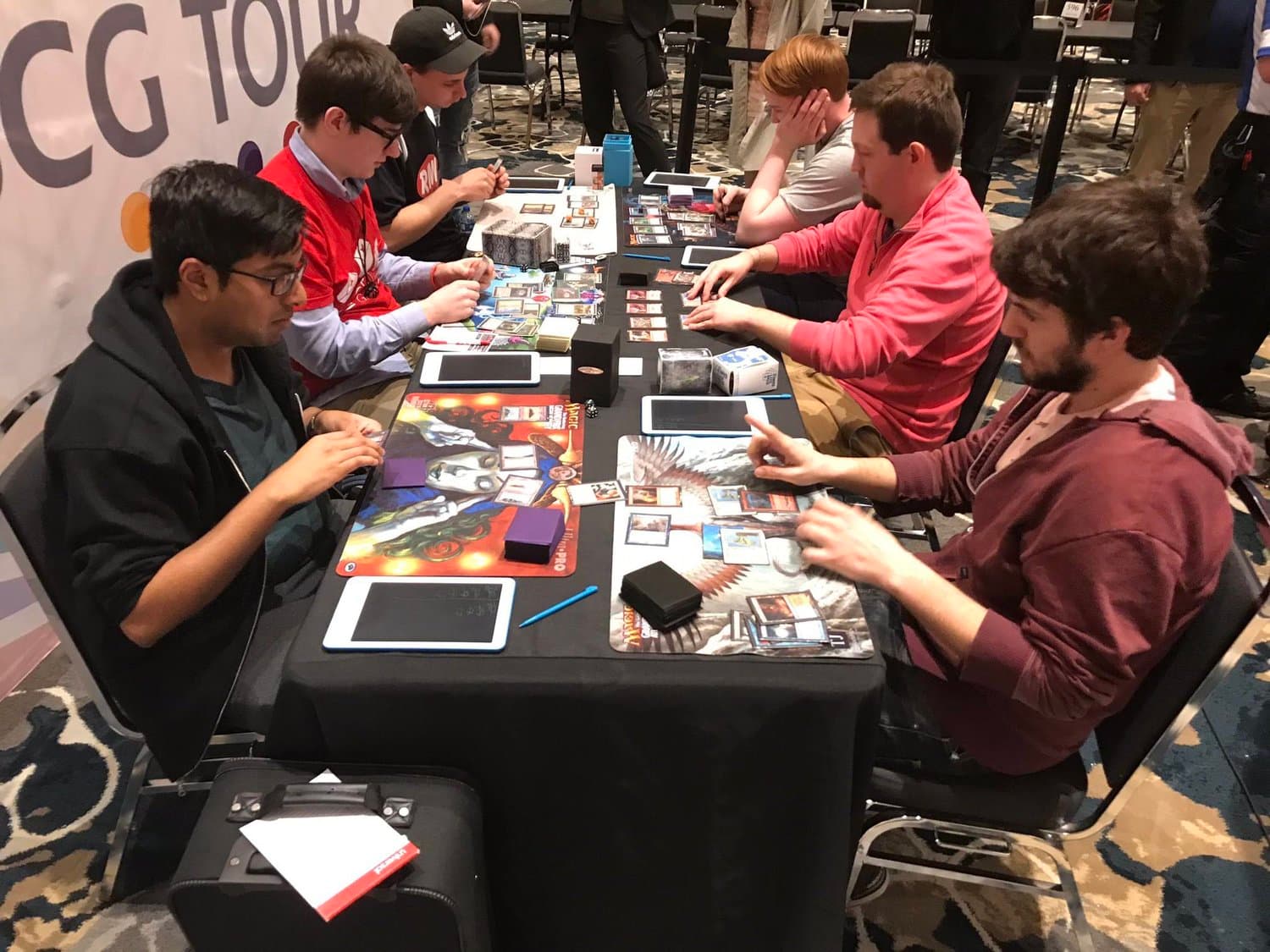This past weekend, I had achieved my first major magic result. I top 8'd the Star City Games Team Constructed Open in Cincinatti, OH, in the Legacy seat, playing alongside my teammates Jake Tilk on Wu Aggro and Chase Masters on BW Eldrazi Taxes. I'll leave my teammates to tell their stories should they wish, so I'll be focusing on my own tournament performance, as well as my preparation leading up to the event.
As you've likely seen in a bit of my other pieces, I was testing UW Delver/Blade and Miracles the weeks leading up to SCG Cinci. Upon seeing the results from the Syracuse Legacy Open, and looking at a few of the lists there in my last article, I came up with the conclusion that UW Miracles was likely going to be the way to go if I were to register Miracles. However, in all of my years of playing Miracles in Legacy, I've literally never registered without playing the Red splash in my deck, and I knew that there would be some amount of work required to relearn some matchups, so I took a list that looked good to me, and started my testing with Sam Roukas's list from SCG Syracuse, and you can watch a few of the matches I tested against one of the most problematic matchups without red, the mirror match.
I eventually arrived at list pictured below. Please excuse the vanity for a moment, I really enjoy showing off my paper cards, and I only really get to do so when preparing or a paper event.



Min's Decklist - Top 8 SCG Cincinatti
Card Selection
There's quite a bit to unpack here, but when testing UW compared to UWr, I noticed something that I first found rather difficult to qualify - that UW Miracles played a lot more like a deck than a true control deck. It seemed odd to me that this was the case, since all I was doing was cutting the red splash element for more counterspells, right? Well, not exactly. In UW, you get to leverage the power of as a one-sided armageddon fairly often, and thus, you have more 'bomb'-esque cards at your disposal. In UWr, your win condition slots were often 0-2 , 0-3 , and 2-3 s as cards that simply forwarded your game plan, often erring on the side of 2/2/3 splits of those elements. However, UW gets to also play 2 copies of that, even now, is a massive sledgehammer in the metagame of Legacy. Thus, my threat suite went from 7 to 9, which is actually a massive difference in a cantrip-based deck like Miracles.
The sideboard might look disjointed, being full of one-ofs like , , etc, but the reasoning for some of the numbers plays into the philosophy of building a full 75 that allows me to switch between roles as a matchup dictates. I'll break down the sideboard below:
1 /1 - These cards are somewhat interchangeable because they essentially fill a win condition slot against matchups in which my g1 win conditions don't work fully well against a specific matchup, so I can swap around what win condition I want to lean more heavily on in a specific game. For example, against Delver, I can't really afford to lean on Jaces as much as I'd like to, so I board in both of these and take out some number of my Jaces in order to maintain a high 'bomb' count. However, all of them come in a fair amount of matchups, allowing me to remove some of the reactive elements in my deck, like Plow and , and present more of a proactive angle of attack, against blue midrange mirrors primarily.
2 /1 - These cards are similar to the above in terms of where they come in, but allow to a different sort of angle of attack that often helps supplement the other win conditions in some ways. Clique -> B2B/CB/JTMS/Mentor is a fairly common sequence and there are a multitude of matchups in which the flying body of the Clique has some relevancy in it, as does the combination of Clique + to stabilize a few matchups, such as BG Depths. is a sort to catchall in some matchups in which I wanted help, as the matchup spread in which it is relevant is somewhat odd. It's great against DnT to help alleviate pressure from locks, while also being a strict upgrade compared to basic plains against most combo decks.
1 /1 - These cards are to have small edges in certain matchups that I perceived as difficult without additional help. The verdict against the new slew of Delver decks that have sticky and hard hitting threats, and the purge is great against BG Depths, MonoRed Stompy, and has relevancy against Grixis Control and the Delver decks as well.
1 /1 - This was part of a relatively new approach in hedging a few matchups across the board, both combo and fair. Snare's stock in Legacy has increased quite a bit in the past few weeks, as 2 Color Delver decks leaning heavily on large number of s, as well as the recent rise of s, and to help solve another loss due to lack of red: Snapcaster Mirrors. is a good magic card of course, but I have not been a fan of it in most of Legacy's matchups and it does not line up very well in how we mostly have to sequence our mana in most game ones.
The rest of the sideboard slots are somewhat self-explanatory: additional slots dedicated towards combo hate and chalice hate, and the main deck remained largely the same, though I opted to go with the 2 + 4 distribution of cantrips/card advantage, as opposed to the 4 + 2 version Sam originally had. This was due to a few small reasons, but the primary reason was actually ease of use. I think AK is a lot easier to plan my early turns around, as it does not ask you to sequence your cantrips nor fetchlands in a specific way, as Lawrence Harmon wrote in his original article. AK is also a self-contained engine, so you don't have to worry about getting shut down by Chalice in some cases, and you will usually pull out ahead of a match goes arbitrarily late, which helps you once again hedge against some matchups that you lose percentages against if you have no red splash.
Event Overview
I'm not going to go into a round-by-round breakdown, as I think that would be dreadfully boring, but I want to definitely highlight a few of my matches from this weekend.
My personal record was as 8 Wins, 4 Losses, 1 Intentional Draw, and 3 Unfinished Matches. I defeated Sneak and Show, Turbo Depths, Lands, BR Reanimator, UR Delver, 4c Loam (the eventual winner!), MonoRed Stompy, and UR Delver. I lost to Sneak and Show, Dredge, ANT, and 4c Loam in the Quarterfinals. Of my unfinished matches, I was quite behind against Grixis Control in game 3, extremely far ahead against UR Delver in game 2 and up a game, and was sideboarding for game 2 against Sneak and Show after having lost game 1.
The first match I'd like to discuss is my match against Grixis Control: In game 1, my opponent had almost ground me to dust, with a on 7 loyalty. On my own turn, I sequenced my cantrips to maximize my possible looks for my last out: the one left in my deck. With the last look, >Shuffle, 3 mana open…hit. I kill the Liliana but end up losing to a Jace a few turns later, sadly. In game 2, I am able to power through a Liliana emblem with 2 s, and was able to hit for exact lethal before being overwhelmed by a horde of lethal zombies. I think I was quite behind in game 3, but my opponent was extremely pleasant and we had a fantastic match overall.
The second sequence of matches I wanted to discuss was my UR delver matchups. Only one of them was extremely interesting, but the first thing I wanted to touch on was a boarding plan that we developed that was critical to my success in this matchup. I boarded out all of my s, my , and down to 2 or 1 Jaces, while boarding in all of the 1 CMC countermagic, the , the , the , and the Mentor. I proceeded to play like Blue Jund, a strategy we developed a few years ago in Top-era Miracles in which we operated as a deck that did its best to never trade negatively in mana trades, and do your best to extract as much value as possible from your spells. Dazes are actually quite a cost for UR delver since their best threat against Miracles is 3 mana, and it requires RUU in order to properly deploy, protect, and utilize to get across the last bits of damage against us. This strategy worked flawlessly in all but one of my games against the deck, and the game in question I kept a very suspect hand of 2 s, 1 Jace, and 4 lands.
In round 13, I played against my second UR Delver opponent, and in Game 3 of our match, I realized that my opponent was likely going to try to play me into a draw, as they had next to no pressure in play, but I was running very low on cards in my library, as well as relevant win conditions left. I engineered a sequence that made the following happen: I would Jace ult my opponent, so that their remaining 2 bolts would be unable to tag the 1 relevant win condition left in my library, the last Monastery Mentor. It worked, and I was able to defeat my opponent on turn 5 of extra turns, for exact lethal. It was easily the craziest match I'd played this past weekend and my opponent played exceptionally well, so I was very pleased with executing the plan.
Finally, my matches against Chris Minor, the eventual winner, were fantastic. I won both post board games in our first match, with him having kept clunky post board hands that I was able to pick apart and aggro him out with Mentor before he could set up shop. Our titanic game 3 in the Quarterfinals was won by him on the back of 2x and backed up by . His game plan revolved around noncreature threats post board, and leaned away from and , so I shaved all of my removal except for a few plows to respect . I think we both played as tight as we could in our matches and Chris was a pinnacle of an opponent, I'm truly happy he was able to take the trophy home.
My teammates and I were disappointed that our run ended in the Quarterfinals, but I was extremely happy to get as far as we did. This was truly my first big paper event finish with Miracles since I started playing Legacy in 2013. All of the work and testing that went into this event truly came to fruition at the open, and I was able to leverage all of my testing knowledge. Each and every single deck building decision truly pulled its weight over the course of the weekend.
The 75 cards here were engineered to have a very singular game plan in most matchups: stabilize behind a permanent of some sort, have a clean and difficult to disrupt manabase so you don't have to fight against developing your mana in order to cast your spells. The only double manacost spells are often sorcery-speed based spells, such as and . I never have the need to pass the turn with UU up because I am not playing main, and only really bring it in matchups where my mana development won't get disrupted. I think this mentality and understandng of mana development is one of the keys to success in playing a deck like this, where the manabase is one of your biggest strengths. Thus, putting less overall strain on it will allow you to leverage the powerful tools at your direct disposal.
I want to make sure to give a special thank you to Josh Shields and Luke Strasler @Lighlee_Salted for helping me test for this event, letting me run ideas by them and test the list with me, the Columbus magic community for cheering me on throughout the day, as well as my Miracles Cabal friends. Last but not least, my awesome teammates Chase Masters and Jake Tilk for helping me pilot my favorite deck to a top 8 finish, finally!

